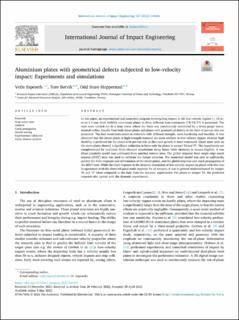| dc.contributor.author | Espeseth, Vetle | |
| dc.contributor.author | Børvik, Tore | |
| dc.contributor.author | Hopperstad, Odd Sture | |
| dc.date.accessioned | 2023-02-16T09:31:23Z | |
| dc.date.available | 2023-02-16T09:31:23Z | |
| dc.date.created | 2022-06-04T15:33:48Z | |
| dc.date.issued | 2022 | |
| dc.identifier.citation | International Journal of Impact Engineering. 2022, 167 . | en_US |
| dc.identifier.issn | 0734-743X | |
| dc.identifier.uri | https://hdl.handle.net/11250/3051381 | |
| dc.description.abstract | In this paper, an experimental and numerical program investigating impact in the low-velocity regime ( m/s) on 1.5 mm thick AA6016 aluminium plates in three different heat treatments (T4/T6/T7) is presented. The tests were carried out in a drop tower where the force was continuously monitored by a strain-gauge instrumented striker. Results from both intact plates and plates with geometrical defects in the form of pre-cut slits are presented. The heat treatments result in materials with different strength, work-hardening and ductility. It was observed that the intact plates in high-strength material are more resilient to low-velocity impact whereas high ductility is preferred for the plates with pre-cut slits as the crack growth is more restrained. Quasi-static tests on the same plates showed a significant reduction in force only for plates in temper T6 and T7. The experiments are complemented by nonlinear finite element simulations using linear brick elements in Abaqus/Explicit. A von Mises plasticity model was calibrated from notched tension tests. The global response from single edge notch tension (SENT) tests was used to calibrate the failure criterion. The numerical model was able to sufficiently predict the force response and deformation of the intact plates, and the global response and crack propagation of the SENT tests. While the force response in the dynamic simulation of low-velocity impact on plates with slits was in agreement with the observed quasi-static response for all tempers, it was in general underestimated for temper T6 and T7 when compared to the data from the dynamic experiments. For plates in temper T4, the predicted response also agreed with the dynamic experiments. | en_US |
| dc.language.iso | eng | en_US |
| dc.publisher | Elsevier Ltd. | en_US |
| dc.rights | Navngivelse 4.0 Internasjonal | * |
| dc.rights.uri | http://creativecommons.org/licenses/by/4.0/deed.no | * |
| dc.title | Aluminium plates with geometrical defects subjected to low-velocity impact: Experiments and simulations | en_US |
| dc.title.alternative | Aluminium plates with geometrical defects subjected to low-velocity impact: Experiments and simulations | en_US |
| dc.type | Peer reviewed | en_US |
| dc.type | Journal article | en_US |
| dc.description.version | publishedVersion | en_US |
| dc.source.volume | 167 | en_US |
| dc.source.journal | International Journal of Impact Engineering | en_US |
| dc.identifier.doi | 10.1016/j.ijimpeng.2022.104261 | |
| dc.identifier.cristin | 2029511 | |
| dc.relation.project | Norges forskningsråd: 250553 | en_US |
| dc.source.articlenumber | 104261 | en_US |
| cristin.ispublished | true | |
| cristin.fulltext | original | |
| cristin.qualitycode | 2 | |

